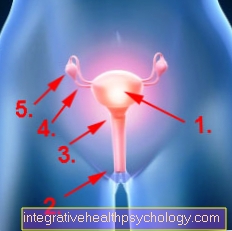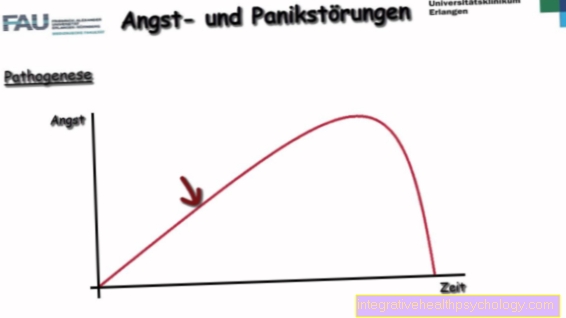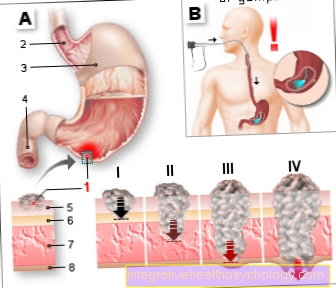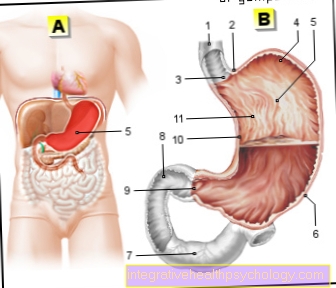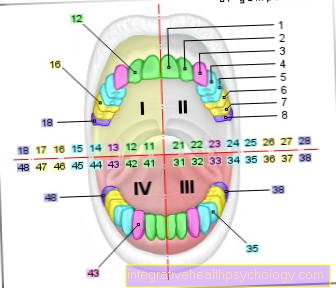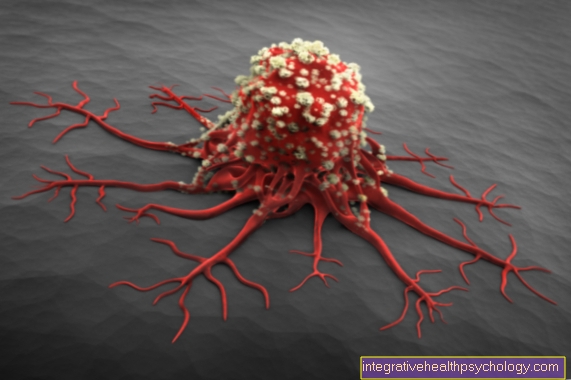Pulmonary Hypertension - How Dangerous Is It?
Introduction: what is pulmonary hypertension?
When one speaks of pulmonary hypertension, what is actually meant is high blood pressure that only occurs in the lungs.
Similar to normal high blood pressure (whereby the blood pressure in the entire body circulation is increased), there is a change in blood pressure due to many causes. This affects breathing and also has a negative impact on the heart - especially the right half of the heart.
Overall, pulmonary hypertension is a rare disease.

What are the causes of pulmonary hypertension?
There are many causes of pulmonary hypertension.
How often the respective causes occur depends primarily on the age of the person concerned.
In old age, the cause of pulmonary hypertension is usually a weakness in the left half of the heart.
As a result, the heart can no longer pump the blood well into the body, causing it to back up in the lungs.
This creates a quasi-congestion of blood there, which causes high blood pressure in the lungs.
Many diseases of the lung tissue such as COPD (chronic obstructive pulmonary disease) can also cause pulmonary hypertension.
Changes in the tissue also affect the vessels in the lungs, which can lead to pulmonary hypertension.
In younger people, pulmonary hypertension often has a genetic component.
So the predisposition for it can be inherited.
This is due to various mutations in certain genes that regulate the resistance in the vessels of the lungs.
Dysregulation due to a mutation can lead to increased blood pressure in the lungs.
People born with a heart defect are also more likely to develop pulmonary hypertension.
This is due to the changed flow conditions of the blood, which can lead to overloading of both the left and right halves of the heart.
The blood builds up in the lungs and pulmonary hypertension occurs.
Small blood clots that lodge in the vessels of the lungs can also cause pulmonary hypertension.
This is how you treat pulmonary hypertension
The treatment of pulmonary hypertension initially depends on whether there is an underlying disease that can be treated.
If, for example, cardiac insufficiency or a disease of the lung tissue is the trigger for pulmonary hypertension, these diseases should first be treated before special therapy has to be initiated.
Drug treatment for pulmonary hypertension consists of a combination of drugs that widen the blood vessels in the lungs and reduce small inflammation in the lungs.
In addition, water tablets can be used to minimize water retention.
Oxygen therapy can also be used if the oxygen saturation in those affected falls below 90% (see also: decreased oxygen saturation).
Pulmonary hypertension is often associated with iron deficiency, so an iron infusion can help.
There are also special sports rehabilitation programs that are designed to improve physical performance.
In addition, affected smokers should stop smoking; weight reduction in overweight people can also improve the symptoms.
Operations are used as the only curative (healing) therapy.
If small blood clots are the cause of the pulmonary hypertension, they can be removed by surgery.
In the hereditary or idiopathic form, a heart-lung transplant is often the only chance of recovery.
These drugs are used
Special drugs against pulmonary hypertension are characterized by their vasodilating effect.
If the vasoreactivity test is positive, the pulmonary hypertension is reduced particularly strongly when nitric oxide (NO) is administered.
Because the vasoreactivity test tests whether nitric oxide leads to the expansion of the blood vessels to success.
In this case, calcium channel blockers such as amiodarone can be used.
Other drugs act directly on the vessel walls, such as the endothelin receptor antagonists (ambrisentan, bosentan, macitentan).
PDE-5 inhibitors such as sildenafil and the drug riociguat have a vasodilatory effect by interfering with the metabolism of nitric oxide.
This is the prognosis for pulmonary hypertension
Pulmonary hypertension is a disease that can only be cured in a few cases.
Most of those affected therefore keep the disease their entire life.
The only chance of cure is the pulmonary hypertension caused by blood clots.
These can be peeled out in an operation that takes 8 to 10 hours so that pulmonary hypertension is no longer detectable afterwards.
For the other forms of pulmonary hypertension, the prognosis usually depends on the underlying disease (often heart disease, including lung tissue disease).
You can read about life expectancy with coronary artery disease in our article: Life expectancy with coronary artery disease
Which values are normal, which are abnormal?
Many different values can be measured in pulmonary hypertension.
In the cardiac catheter, the main thing that matters is the pressure in the pulmonary circulation.
If this is above 25mmHg on average, one speaks of pulmonary hypertension.
The oxygen saturation in the blood also plays a role.
Usually it is over 95%.
Under 90% there is definitely a disorder of oxygenation (enrichment of the blood with oxygen), which can indicate high lung pressure.
To identify damage to the heart, the NT-proBNP value is measured in the blood.
These are peptide hormones that are released when the left ventricle is stretched too much.
The NT-proBNP value in healthy people is below 100 pg / ml and in sick people can quickly be well over 1,000 pg / ml, often even over 10,000 pg / ml.
The value of oxygen saturation in sick people
The oxygen saturation indicates how well the blood is enriched with oxygen.
In healthy people, this value is over 95%.
In people who suffer from pulmonary hypertension, the value can also be over 95% at rest, but it often falls below 90% in stress tests such as the 6-minute walk test.
If the oxygen saturation is often below 90% even at rest, long-term oxygen therapy must be considered.
Pulmonary hypertension can be recognized by these symptoms
The symptoms of pulmonary hypertension are diverse and extremely unspecific, which is why the disease is often recognized very late.
Usually the first signs are a decreased resilience and performance.
This is particularly the case with physical exertion such as sport or climbing stairs.
But also carrying heavy loads is often difficult for those affected.
In addition, there is often increased fatigue.
In advanced stages of the disease, there is shortness of breath with little physical exertion or even at rest.
In addition, the heart is damaged by the increased blood pressure in the lungs, which is why the blood flows back into the body.
As a result, water is stored on the ankles and lower legs, for example.
Cardiovascular disorders such as dizziness and fainting spells can also be triggered by the damage to the heart.
The lungs' reduced ability to transport oxygen into the blood can also lead to what is known as cyanosis.
This is an undersupply of tissue with oxygen, which can cause the lips or fingers, for example, to turn bluish.
Course of the disease and consequences of pulmonary hypertension
At the beginning of the disease there is usually a slightly increased blood pressure in the pulmonary circulation.
Because of this increased blood pressure, the right half of the heart has to provide more pumping capacity.
Usually, this first trains the heart muscles, they thicken and become stronger.
The effect is comparable to a muscle that is trained by strength training.
Over time, however, the pulmonary hypertension increases, so that the heart has to perform ever better.
At a certain point, even the trained heart muscles can no longer generate the necessary force, the blood can no longer be completely transported from the heart to the lungs.
The result is a congestion of blood in the right half of the heart, the right ventricle and the right atrium enlarge.
The change in the structure of the heart leads to cardiac arrhythmias.
In addition, the blood backs up in the body, which leads to increased water retention.
While symptoms such as shortness of breath and dizziness initially only occur with heavy physical exertion, they become more common over time.
Because of its increased stress, the heart is less and less able to generate the additional pumping power required during physical activity.
What sport can you do with pulmonary hypertension?
In the case of pulmonary hypertension, endurance sports are particularly recommended.
This includes, for example, cycling and jogging.
Nordic walking and regular walks are also suitable sports.
Whether someone should swim with pulmonary hypertension depends on the severity of the disease, as the water also exerts pressure on the chest from outside.
Sports that involve short-term great exertion are rather unsuitable.
Weight sports such as weightlifting should therefore be avoided.
You can find out more about the general effects exercise can have on high blood pressure in our article: High blood pressure and exercise - What should be considered?
This is what the end-stage pulmonary hypertension looks like
The end stage of pulmonary hypertension is primarily characterized by right heart failure, i.e. weakness in the right half of the heart.
The right half of the heart has to constantly pump against the high blood pressure in the lungs.
If the heart can no longer apply the necessary pressure, however, the right ventricle and the right atrium in the heart enlarge.
Cardiac arrhythmias develop, which often cause fainting and dizziness.
The build-up of blood in the right heart leads to increased water retention, especially in the legs.
In addition, the shortness of breath becomes noticeable even with the slightest physical exertion or at rest.
You can read in the following article how water retention in the legs, so-called edema, is best treated: This is to be done with water in the legs
What is the life expectancy with pulmonary hypertension?
Life expectancy with pulmonary hypertension is heavily dependent on the disease underlying the increased blood pressure.
If the underlying disease is easily treatable (such as pulmonary hypertension, which is triggered by many small blood clots), life expectancy is very good.
People with pulmonary hypertension due to a congenital heart disease or an acquired weakness of the left heart usually survive for a long time.
However, if it is hereditary or idiopathic form of pulmonary hypertension, life expectancy at the time of diagnosis is very limited.
One assumes only about 70-80% survival rate within 3 years.
What influences life expectancy?
Life expectancy is primarily influenced by how severely the heart is damaged by pulmonary hypertension.
Usually the right half of the heart takes a long time to fight the high blood pressure.
At some point, however, the heart decompensates, then it is no longer able to pump against the high pressure, and within a very short time there is a massive backlog of blood into the body's circulation.
This is often accompanied by severe cardiac arrhythmias that can lead to sudden death.
The therapy for such acute worsening of the right heart consists of a strong diuretic treatment in which a lot of fluid is excreted from the circulation using strong water tablets or infusions.
How does the doctor diagnose excessive pressure in the lungs?
The diagnosis of pulmonary hypertension is usually made very late, i.e. when the disease is already advanced.
The reason for this is the rarity of the disease, which is why affected people are often only tested for the disease after a few months to years.
If symptoms occur, an ultrasound of the heart is usually performed first.
An enlargement of the right half of the heart and a change in the flow conditions of the blood can be noticed.
The final diagnosis is made using a cardiac catheter.
A wire is usually pushed from the neck to the heart.
The blood pressure can be measured there and thus an increased pressure in the pulmonary circulation can be determined.
You can read more information in the following articles:
- These are the causes of shortness of breath
- What are the causes of acute lung failure and how is it treated?
- Water In Your Lungs - What To Do About It
- Everything you should know about pneumonia


